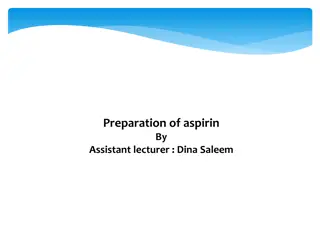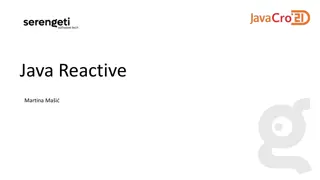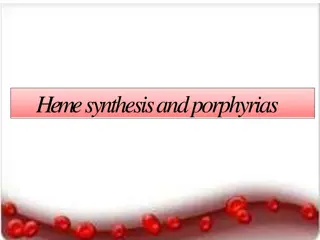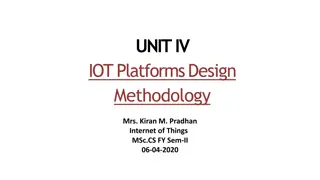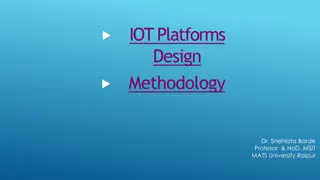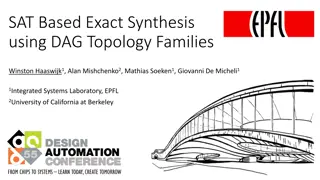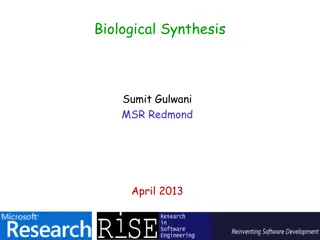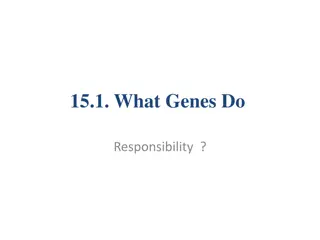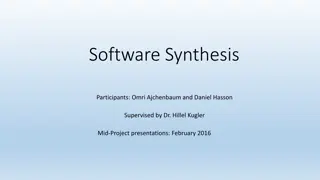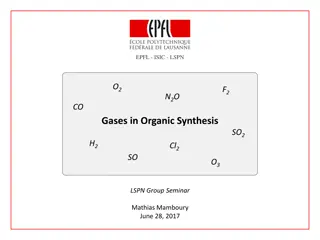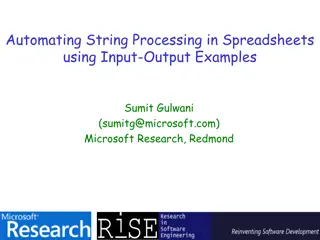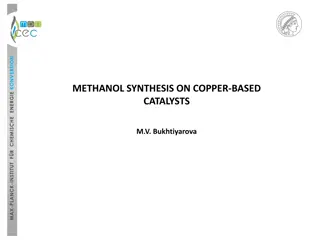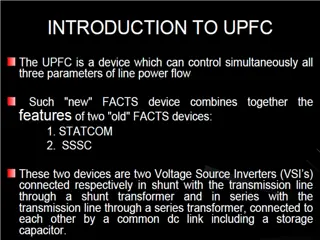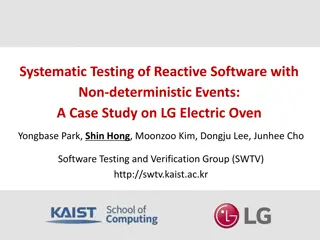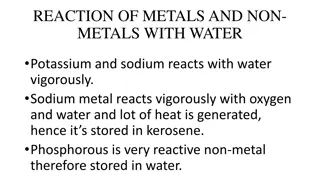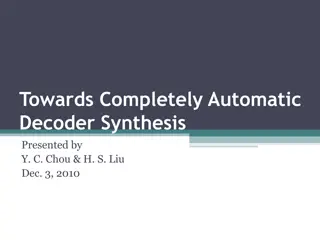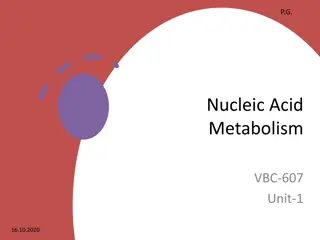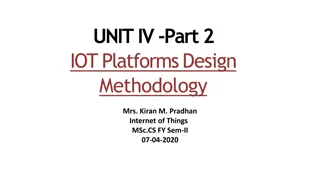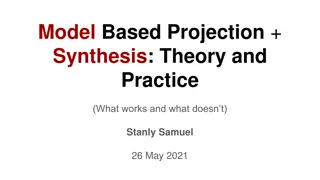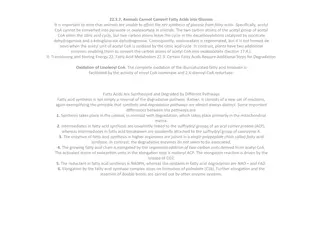Specification Format for Reactive Synthesis Problems
This specification format addresses reactive synthesis problems, focusing on simple arbiter granting requests without spurious grants. It delves into LTL properties, implementation through synthesizers, automata handling, and proposed formats for fast synthesizers integrated into existing programming languages like SMV. The format requirements, comparisons with other tools, and practical examples further elucidate the topic.
Download Presentation

Please find below an Image/Link to download the presentation.
The content on the website is provided AS IS for your information and personal use only. It may not be sold, licensed, or shared on other websites without obtaining consent from the author.If you encounter any issues during the download, it is possible that the publisher has removed the file from their server.
You are allowed to download the files provided on this website for personal or commercial use, subject to the condition that they are used lawfully. All files are the property of their respective owners.
The content on the website is provided AS IS for your information and personal use only. It may not be sold, licensed, or shared on other websites without obtaining consent from the author.
E N D
Presentation Transcript
Specification Format for Reactive Synthesis Problems Ayrat Khalimov SYNT 2015
Simple arbiter g r Every request should be granted : ?(? ??) No spurious grants Let s specify spurious grants in RE: .,. (.,?) ?, ?+ ?,?
.,? ?,?+ (?,?) In LTL: .,. ? ? ? ? ? ? ? ? ? (NO! It accepts (? ?)( ? ?)) ? ? ? ?( ? ? ? ? ? ?) ? ?(? (? ? ( ? ? ( ? ? ? ? ?))))
Synthesis flow LTL properties implementation synthesizer
Synthesis flow LTL properties implementation synthesizer RE automata partial synthesizer that can handle the format implementations format that supports these all
Synthesis flow any translator into SYNTCOMP SYNTCOMP synthesizer implementation LTL properties RE automata partial implementations
Outline of the talk any translator into SYNTCOMP SYNTCOMP synthesizer implementation LTL properties RE automata partial implementations translator new format (extended SMV) synthesis example: a Huffman encoder extended SMV -> SYNTCOMP
Format requirements embedded into existing programming language modular property language agnostic (LTL, RE, automata ) fast synthesizers
Proposed format embedded into existing programming language - SMV modular - part of SMV property language agnostic (LTL, RE, automata ) - automata fast synthesizers - SYNTCOMP
Comparison with ([1])([2]) embedded into existing programming language - SMV (SMV) (Promela) modular - part of SMV (part of SMV)(part of Promela) property language agnostic (LTL, RE, automata ) - automata (LTL patterns)(LTL + relations) fast synthesizers - SYNTCOMP (original GR1)(SLUGS GR1)
FORMAT DESCRIPTION EXTENDED SMV
SMV format MODULE main VAR input: 0..10; state: boolean; x: 0..10; variables DEFINE x_is_2input := (x=input+input); macros ASSIGN init(state) := FALSE; next(state) := (x=0 | x_is_2input); init(x) := 0; next(x) := x+input; LTLSPEC G(state | (x!=10)) variables behaviour specification
SMV format (cont.) MODULE module1(i1,i2) VAR x: ... ... i1 module1 i2 MODULE module2(i1) VAR out : ... i1 module2 MODULE main VAR input: ... VAR m1: module1(input, m2.out); m2: module2(m1.x); input i1 out m1 m2 i2 x
Extended SMV Only main can have specifications LTL, LDL, RE, patterns? relations? only safety assumptions
SYNTCOMP format Standard: ? ??? Extended with liveness: ( ??? ? ???) (? ??? ?? ????)
Working flow automata: determinization complementation flattening into a boolean SMV module boolean SMV to AIGER translation aisy.py or from SYNTCOM P
Huffman encoding 01,101,1101,... A,B,C,... A,B,C,... encoder decoder more often appearing letters have shorter ciphers
Letters frequency table +-------------( )---------------+ | | +-------( )------+ +------( )-----+ | | | | | | | | +----( )----+ ( ) +--( )--+ ( ) | | / \ | | / \ | | | | | | | | +--( )--+ ( ) [E] ( ) ( ) ( ) [ ] ( ) | | / \ / \ / \ / \ / \ | | | | | | | | | | | | ( ) ( ) [S] ( ) ( ) [A] [I] [O] [R] [N] ( ) [T] / \ / \ / \ / \ / \ | | | | | | | | | | [U] [P] [F] [C] ( ) [L] [H] ( ) [D] ( ) / \ / \ / \ | | | | | | +----( ) [W] [G] [Y] ( ) [M] | \ / \ | | | | ( ) ( ) [B] [V] / \ / \ | | | | [Q] ( ) [K] [X] / \ | | [Z] [J]
Synthesizing a Huffman encoder Specification A1. input ?????? is within range 1..27 A2. ?????? does not change until incl. the moment when ???? is high G1.?(???? ? ?????? ) G2.? ???? G3.?? ????
Info about the synthesis The specification: - # latches = 45 - # AND gates = 3k The model has: - # AND gates = 130k (120k) Timings: - 2min (4min) The model is as expected
Conclusion & discussion Adapted the SMV format to synthesis tasks Provided scripts to translate into the SYNTCOMP Is SMV good enough or Verilog should be used? Should we support LTL/RE formats? Should we support GR1 or full LTL semantics? Should we support partial information? Simpler ways to translate? thank you


